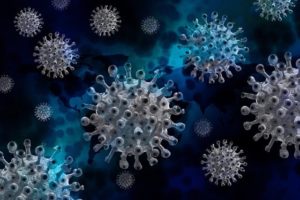SARS-CoV-2 Transmission To, From, and Among Children: What’s New?
SARS-CoV-2 Transmission To, From, and Among Children: What’s New?
April 30, 2021
The dynamics of infection of children has been of great interest, particularly as it pertains to the issue of whether or not to open schools and to vaccinate children. The discussions have at times been contentious. There are multiple aspects to the issue. How likely are children to get severe COVID-19, transmit virus to other children and to the community? How likely are they to be infected by adults? And finally, what can we learn from the generally milder outcomes of infection in children?
 School Transmission
School Transmission
The biggest area of concern involves the question of virus transmission within schools, as this is a critical consideration in reopening schools. An early report on transmission in reopened schools in the UK in the summer of 2020 indicated that cases of infection were relatively few(1). However, of 177 cases identified, 31% were likely transmitted within the school. Only a small fraction of infections occurred student to student; most were staff to student, student to staff, or staff to staff. Another early study also showed an apparently reduced rate of transmission of SARS-CoV-2 among children(2). In daycare centers in France, seroprevalence survey of antibodies against SARS-CoV-2 showed that the proportion of young children with SARS-CoV-2 infection was low. Intrafamily transmission seemed more plausible than transmission within daycare centers (3). Indeed, a survey of pediatric household contacts demonstrated that children and adults had similar secondary infection rates, but children generally had less frequent and severe symptoms (4). In yet another report, a 9-year-old child coinfected with SARS-CoV-2, picornavirus and influenza A exposed more than 80 other students in three schools; yet they showed no secondary SARS-CoV-2 infections, even though there were numerous influenza infections within the schools, indicating that the environment was conducive to respiratory infections(5). Increases in incidence among children do not seem to predate increases in community transmission (6), thus suggesting they are not drivers of community outbreaks.
There are factors, however, that could lead to underestimate the likelihood of transmission within schools. The first cited study(1), showing lower transmission rates, only looked at partially reopened schools with small classes or at half empty schools. Probably the biggest factor that could lead to underestimation is the greater tendency of young children to have inapparent infections. If testing is not done randomly but rather is focused on symptomatic infections, it could lead to a considerable undercount of transmissions. However, most recent studies also agree that elementary school-associated SARS-CoV-2 transmission is low. Specifically, in a high community transmission setting in Salt Lake County, Utah, low school-associated transmission was observed with a 0.7% secondary attack rate (7); of note mask adherence was high, but students’ classroom seats were <6 ft apart and a median of 3 ft apart. These findings suggest that in-person elementary schools can be opened safely with minimal in-school transmission when critical prevention strategies including mask use are implemented. It is also likely that transmission occurs more readily in secondary than in primary schools, and in college more readily yet. A later report showed an incidence of SARS-CoV-2 infection in elementary school children in the UK in October 2020 to be about 1%. One of the common routes of transmission among children is through group contact sports, especially in older children.
The biggest area of concern involves the question of virus transmission within schools, as this is a critical consideration in reopening schools. An early report on transmission in reopened schools in the UK in the summer of 2020 indicated that cases of infection were relatively few(1).
Increases in incidence among children do not seem to predate increases in community transmission (6), thus suggesting they are not drivers of community outbreaks.
The reason for their reduced disease burden seems to be related to an innate mucosal immune response that favors a strong interferon response and a somewhat less active inflammatory response.
The Importance of Testing
In this context a major tool to help prevent school contaminations is the implementation of rapid and repeated testing for SARS-COV-2 RNA. Thus, it is now feasible to use salivary-based testing coupled with either classical PCR or novel molecular assay (such as LAMP) to provide much more rapid results; it is also feasible to associate antigen testing to salivary tests (8-14). This has been initiated in several countries and will pave the way to maintain our community, including for future pandemics, and school activities, a major obstacle for our society while we face challenges to fight contagious viruses.
 Age-Related Differences in Response
Age-Related Differences in Response
Is there some reason to think that children might be less able to transmit virus to others? What about the ability of children to shed virus? A recent study reported no age-related differences in viral RNA titers. Thus, it might be inferred that children are quite capable of spreading virus and contributing to community infection rates. It is not certain, however, that viral RNA titers correspond to live virus load. A recent study showed that as of late October 2020, people between ages 20-49 were the only groups for which the reproductive number was >1(15). Thus, viral load is not the only factor to be considered; in fact, the bases of community spreading through school attendance is as of yet unsettled.
Although there seem to not be great differences in susceptibility to infection, there are large age-related differences in mortality and symptomatic infection rates(16). Can we learn anything from the apparent lower disease incidence among infected children? One idea was that reduced or altered expression of the ACE2 receptor in tissues of children might offer an explanation, but such studies are difficult and in any event, extreme variation in ACE2 expression among age-matched individuals(17) makes this explanation unlikely. More persuasive is the finding of much more active type 1 interferon responses relative to inflammatory responses in children(18, 19). Interestingly, several studies have shown distinct antibody responses in children and adults after SARS-CoV-2 infection. Specifically, adult COVID-19 cohorts had anti-spike (S) IgG, IgM and IgA antibodies, as well as anti-nucleocapsid (N) IgG antibody, while children with and without multisystem inflammatory syndrome in children (MIS-C) had reduced breadth of anti-SARS-CoV-2-specific antibodies, predominantly generating IgG antibodies specific for the S protein but not the N protein (20). Moreover, children with and without MIS-C had reduced neutralizing activity as compared to both adult COVID-19 cohorts, indicating a reduced protective serological response. These findings suggest that children may clear SARS-CoV-2 more efficiently than adults, and they may not need a strong antibody immune response to get rid of the virus.
Conclusion
What do we make of all this? Although the issues are not totally settled, it appears that children are able to be infected and transmit the virus to others, although some studies suggest that in the real world they do so with a reduced frequency. The reason for their reduced disease burden seems to be related to an innate mucosal immune response that favors a strong interferon response and a somewhat less active inflammatory response. In addition, children have a lot of naive T cells that are able to facilitate recognition of new pathogens, whereas older people depend more on our immunological memories (20). This might also affect the outcome of disease severity between children and adults. Obviously, further studies are required for a comprehensive understanding of the nature of the immune response to SARS-CoV-2 in children.
References
- S. A. Ismail, V. Saliba, J. Lopez Bernal, M. E. Ramsay, S. N. Ladhani, SARS-CoV-2 infection and transmission in educational settings: a prospective, cross-sectional analysis of infection clusters and outbreaks in England. Lancet Infect Dis 21, 344-353 (2021).
- N. G. Davies et al., Age-dependent effects in the transmission and control of COVID-19 epidemics. Nat Med 26, 1205-1211 (2020).
- Lachassinne, E. et al., SARS-CoV-2 transmission among children and staff in daycare centres during a nationwide lockdown in France: a cross-sectional, multicentre, seroprevalence study. Lancet, 5: 256-264, (2021).
- Laws RL, Chancey RJ, Rabold EM, et al. Symptoms and Transmission of SARS-CoV-2 Among Children — Utah and Wisconsin, March–May 2020. Pediatrics. 2021;147(1):e2020027268. doi:10.1542/peds.2020-027268
- K. Danis et al., Cluster of Coronavirus Disease 2019 (COVID-19) in the French Alps, February 2020. Clin Infect Dis 71, 825-832 (2020).
- S. Gandini et al., No evidence of association between schools and SARS-CoV-2 second wave in Italy. medRxiv, 2020.2012.2016.20248134 (2020).
- Hershow RB, Wu K, Lewis NM, et al. Low SARS-CoV-2 Transmission in Elementary Schools — Salt Lake County, Utah, December 3, 2020–January 31, 2021. MMWR Morb Mortal Wkly Rep 2021;70:442–448. DOI: http://dx.doi.org/10.15585/mmwr.mm7012e3
- Ott, Isabel M et al. “Simply saliva: stability of SARS-CoV-2 detection negates the need for expensive collection devices.” medRxiv : the preprint server for health sciences 2020.08.03.20165233. 4 Aug. 2020, doi:10.1101/2020.08.03.20165233. Preprint.
- Butler-Laporte G, Lawandi A, Schiller I, Yao MC, Dendukuri N, McDonald EG, Lee TC. Comparison of Saliva and Nasopharyngeal Swab Nucleic Acid Amplification Testing for Detection of SARS-CoV-2: A Systematic Review and Meta-analysis. JAMA Intern Med. 2021 Jan 15. doi: 10.1001/jamainternmed.2020.8876. Epub ahead of print. PMID: 33449069.
- Julio Silva et al. Saliva viral load is a dynamic unifying correlate of COVID-19 severity and mortality. medRxiv 2021.01.04.21249236; doi: https://doi.org/10.1101/2021.01.04.21249236.
- Yasmin Rafiei, B.Sc., and Michelle M. Mello. The Missing Piece — SARS-CoV-2 Testing and School Reopening. NEJM. DOI: 10.1056/NEJMp2028209.
- DS, Weigl BH, Nichols KP. SARS-CoV-2 Coronavirus Nucleocapsid Antigen-Detecting Half-Strip Lateral Flow Assay Toward the Development of Point of Care Tests Using Commercially Available Reagents. Anal Chem. 2020 Aug 18;92(16):11305-11309. doi: 10.1021/acs.analchem.0c01975. Epub 2020 Aug 5. PMID: 32605363; PMCID: PMC7409939.
- Vandenberg, O., Martiny, D., Rochas, O. et al. Considerations for diagnostic COVID-19 tests. Nat Rev Microbiol (2020). https://doi.org/10.1038/s41579-020-00461-z
- Mina MJ, Parker R, Larremore DB. Rethinking Covid-19 Test Sensitivity – A Strategy for Containment. N Engl J Med. 2020 Sep 30. doi: 10.1056/NEJMp2025631. Epub ahead of print. PMID: 32997903.
- M. Monod et al., Age groups that sustain resurging COVID-19 epidemics in the United States. Science 371, eabe8372 (2021).
- R. Omori, R. Matsuyama, Y. Nakata, The age distribution of mortality from novel coronavirus disease (COVID-19) suggests no large difference of susceptibility by age. Scientific Reports 10, 16642 (2020).
- Z. Inde et al., Age-dependent regulation of SARS-CoV-2 cell entry genes and cell death programs correlates with COVID-19 disease severity. bioRxiv, 2020.2009.2013.276923 (2020).
- C. A. Pierce et al., Natural Mucosal Barriers and COVID-19 in Children. medRxiv, 2021.2002.2012.21251310 (2021).
- C. Wang et al., Multi-Omic Profiling of Plasma Identify Biomarkers and Pathogenesis of COVID-19 in Children. medRxiv, 2021.2003.2004.21252876 (2021).
- Weisberg, S.P., Connors, T.J., Zhu, Y. et al. Distinct antibody responses to SARS-CoV-2 in children and adults across the COVID-19 clinical spectrum. Nat Immunol 22, 25–31 (2021). https://doi.org/10.1038/s41590-020-00826-9
